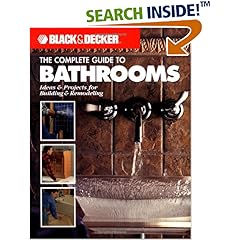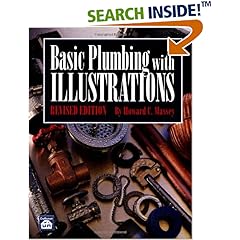
Cast-iron pipe may not win any beauty awards, but it's durable, doesn’t rust easily and lasts darn near forever. It’s extremely heavy, but that mass also muffles sound far better than plastic does. Even today, plumbers will install a length of cast-iron pipe in areas where people may not want to hear the gurgle and sloshing of wastewater.
Older cast-iron pipe (see left image) was joined by packing hubs with oakum and sealing the joint with molten lead. Newer no-hub cast iron is joined using no-hub couplings (see right image) consisting of neoprene sleeves and stainless- steel band clamps. Special transition couplings can be used to tie newer plastic pipe into existing cast-iron systems.

Tying Into an Existing Soil Stack
Cast-iron pipe was once commonly used in house hold plumbing, particularly for the large main soil stack. Cast iron contains about 4 % carbon, which makes it so hard you can barely cut it with metal-cut ting blades. Snapping it, as shown below, is the best way to remove a section while remodeling. Always make certain the pipe is secured well with riser clamps, as shown, before you cut into it to keep the heavy stack from dropping down.
Snap cast-iron soil stack. Measure new cast-iron tee and mark stack for cut ting. Add 1/4 in. (6 mm) to measurement to make sure tee slips in. Wrap cutter chain around the pipe so cutting wheels rest on mark. Lever tool until pipe snaps. Cut at second mark and knock out the section using a hammer and block of wood.
 Steel-sleeved
rubber couplings. Slip rubber and steel couplings
onto cut pipe ends first. Insert cast- iron tee fitting and work
couplings over joints. Use torque wrench to tighten band clamps.
Rubber gaskets should be crimped firmly, but not so tightly that
they bulge out from pressure.
Steel-sleeved
rubber couplings. Slip rubber and steel couplings
onto cut pipe ends first. Insert cast- iron tee fitting and work
couplings over joints. Use torque wrench to tighten band clamps.
Rubber gaskets should be crimped firmly, but not so tightly that
they bulge out from pressure.
Steel Pipe Repairs and Add-ons
You can’t simply unscrew a section of threaded pipe from the middle of your plumbing system to tap into it or make a repair. You need to cut and remove the affected piece of pipe and then use a union (Step 3) and some shorter pieces for reconstructing the section.
1. Turn off water. Cut pipe using a hacksaw. Avoid using a reciprocating saw, because vibration can knock loose mineral deposits that can clog fixtures and faucets.
(continue ...)Recommended Reading
The Complete Guide to Bathrooms: Ideas and Projects for Building and Remodeling
Issues covered: banded couplings, pre pan, glass block mortar, drain tailpiece, split studs, bathroom remodeling projects, glass block shower, shower alcove, shower base, tile caulk, disconnect the plumbing, neon circuit tester, floor mortar, king studs, supply elbow, cable ripper, latex additive, shower panels, basin wrench, jack studs, grout float, masonry chisel, drywall knife, faucet body, seated users.
Reviews:
Good overview but can't do it all: This is a nice overview of bathroom remodeling projects. It's targetted at the DIY-er but even if you're contracting out, it will give you some design ideas and help make you aware of the choices you'll need to consider. It contains a number of how-tos with lots of photos for both demolition and construction or remodeling. However, if you are serious about DIY, this guide is just a start. It lacks detail in many important areas. For instance, the drywall section is a laughable 3-4 pages and the tub installation is definitely minimal. (Nothing in there about framing to make an enclosed tub fit the space!) I don't regret buying the book, but I ended up purchasing additional plumbing, eletrical, drywall, and tile books for my major DIY bathroom remodeling project. Also, for those who own several other Black and Decker home improvement series books, you'll find recycling of many photos and instruction in this guide. There is clear duplication of content with the B&D plumbing and electrical books.
Excellent book: I'm reasonably handy but I don't have any professional construction experience. I'm in the process of completely remodeling a bathroom from the studs and joists in. In preparation, I've read a lot of books on construction and plumbing. This book is my favorite of the bunch.
First, it's VERY well illustrated--you could probably learn 90% of what you need to know just by looking at the photographs.
The captions accompanying the photographs are for the most part reasonably clear. I say "for the most part" because the instructions on installing fixtures suffer a little bitfrom a lack of specificity. You can't really blame the authors for this, though--copper pipes are more or less the same no matter who the manufacturer is, but what's true for a Price Pfister faucet may not always be true for some other brand. On the other hand, the professional advice given in the instructions and sidebars more than makes up for any shortcoming. Personally, I feel like I got my money's worth.
Basic Plumbing With Illustrations
Issues covered: service supply pipe, peak draw period, drainfield absorption area, plumbing plans examiner, water service supply, bathtub waste, minimum toilet facilities, water closet bowl, soil pipe cutter, ratchet threader, water closet trap, water service pipe, combination faucet, water main pressure, interactive multimedia video that shows, water closet tank, inlet tee, sanitary cross, overflow rim, cutting plastic pipe, hydropneumatic tank, asphaltum paint, pipe compound, compression faucet, chain vise.
Reviews:
Quality reference material: Basic Plumbing with Illustrations is a
handy reference book for designers, engineers, and draftsmen. There
are a lot of illustrated examples showing best practices when laying
out residential and light commercial plumbing that minimize extra fittings,
are UPC compliant, and work for stacked and flat systems.
Also handy are rough-in dimensions for common fixtures, drain, waste and vent sizing charts, and cold and hot water supply sizing info.
that includes a neat explanation of solar hot water heating methods.
this reference goes hand in hand with another Massey authored Publication
entitled "Planning, Drain, Waste, and Vent Systems".
Deal for students, apprentices and practicing professionals: Now in a completely revised and updated edition, Howard Massey's Basic Plumbing With Illustrations is the definitive "how to" manual for installing code-approved plumbing in residential and light commercial buildings. Systematically laid out in twenty-three sections, Basic Plumbing With Illustrations covers all of the fundamentals of the plumbing trade including planning and sizing, installation, maintenance, common layout, materials, and code requirements. Invaluable and practical information is provided on inspections, floor plans and plot plans, drawing and reading isometrics, code definitions, and materials. Profusely illustrated with hundreds of charts, tables, installation diagrams, and rough-in measures, Basic Plumbing With Illustrations is enhanced further with a glossary of plumbing terms, plumbing abbreviations, extensive study questions at the end of each section, and a section with all the correct answers. This is the ideal text for students and apprentices, as well as practicing professionals in the field.
Everything is explained in this guide: This book shows you everything about plumbing, including septic systems, solar water heaters, and hooking up swimming pools and spas--not to mention the basic and industrial plumbing fixures and techniques. This book is extremely interesting.
Recommended Products
More

If you need supplies, tools or equipment for your DIY project, we recommend these trusted online merchants...
...they will deliver even the big stuff right to your door -- all at very reasonable prices.
Want to learn more about plumbing? Visit our plumbing library.
Plumbing: 23,000-item online catalog!
Got a wet basement? Visit our site dedicated to Basement Waterproofing.

2. Use two pipe wrenches for disassembly. One turns the pipe, while the hold- back wrench prevents damage farther down the line.
 3. Install a union to reconnect pipe sections after adding
a tee or making repairs. Unions have three parts—a part with male threads
that goes onto the first pipe, a part with only female threads and a
tapered- type joint that goes onto the facing pipe, and a tapered nut
that pulls the parts and pipe together.
3. Install a union to reconnect pipe sections after adding
a tee or making repairs. Unions have three parts—a part with male threads
that goes onto the first pipe, a part with only female threads and a
tapered- type joint that goes onto the facing pipe, and a tapered nut
that pulls the parts and pipe together.

